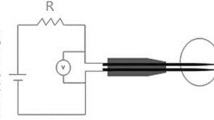Abstract
Gas bubbles play an important role in many liquid metal processing operations. An important example is the “gas fluxing” of aluminum, where a gas, such as an argon-chlorine mixture, is injected into the liquid metal to remove impurities. A proper understanding of the behavior of units such as these is dependent on knowing how the bubbles are dispersed in the metal; other information such as the frequency of occurrence of bubbles at various points in the system would also be useful. Various bubble probes have been used in the past (including a “capacitance probe” developed for this purpose at Berkeley), but all seem to be prone to problems such as attack by the metal, susceptibility to electrical noise, mechanical weakness, high cost, etc. The present article describes a simple and rugged probe consisting of a narrow ceramic tube inserted into the metal at the point of interest and connected at its other end to an inert gas supply. Small bubbles are created at the immersed end of the tube, and the formation of these bubbles is heard by an inexpensive microphone in the gas supply line. These small bubbles, henceforth “probe bubbles,” are not the bubbles to be measured. The latter are much larger, and, as they pass up over the immersed end of the probe, these large bubbles change the sound of the probe bubble formation. The microphone is connected to a sound card in a computer so that the arrival of a large bubble at the probe location is readily recorded. The phenomena involved in this probe have been examined in water using high speed digital movies.















Similar content being viewed by others
References
M. Iguchi, T. Chihara, N. Takanashi, Y. Oqawa, N. Tokumitsu, Z.I. Morita: ISIJ Int., 1995, vol. 35 (11), pp. 1354–61
A.H. Castillejos, J.K. Brimacombe: Metall. Trans. B, 1989, vol. 20B, pp. 595–601
M. Iguchi, H. Kawabata, K. Nakajima, Z.I. Morita: Metall. Mater. Trans. B, 1995, vol. 26B, pp. 67–74
Q.A. Fu, J.W. Evans: ISIJ Int., 1999, vol. 39 (4), pp. 309–18
A.J. Fjeld, J.W. Evans, and N. Mittal: TMS Light Met., 2003, pp. 909–13
E.O. Hoefele and J.K. Brimacombe: Metall. Trans. B, 1979, vol. 10B, pp. 631–48; J.K. Brimacombe and G.N. Oryall: Metall. Trans. B, 1976, vol. 7, pp. 391–403
M. Schneider, J.W. Evans: Metall. Mater. Trans. B, 2006, vol. 37B, pp. 333–37
M. Paneni, W.G. Davenport: Trans. TMS-AIME, 1969, vol. 245 (4), pp. 735–38
F.D. Richardson: Metall. Trans., 1971, vol. 2, pp. 2747–56
R.W. Hughes, L.R. Glicksman, A. Barcohen: Int. J. Multiphase Flow, 1981, vol. 7, pp. 101–13
D. Bhaga, M.E. Weber: J. Fluid Mech., 1981, vol. 105, pp. 61–85
I. Leibson, E.G. Holcomb, A.G. Cacoso, J.J. Jacmic: AICHE J., 1956, vol. 2 (3), pp. 296–306
L. Davidson, E.H. Amick Jr.: AICHE J., 1956, vol. 2 (3), pp. 337–42
S.L. Sullivan, B.W. Hardy Jr., C.D. Holland: AICHE J., 1964, vol. 10 (6), pp. 848–54
G.K. Sigworth, T.A. Engh: Scand. J. Metall., 1982, vol. 11, pp. 143–49
R.M. Davies, G. Taylor: Proc. R. Soc. London, 1950, vol. 200 (1062), pp. 375–90
J. Szekeley, N.J. Themelis: Rate Phenomena in Process Metallurgy, John Wiley, New York, NY, 1971, pp.688–98
Acknowledgments
The costs of this investigation were met by the funds of the P. Malozemoff Chair at UC, Berkeley. The help of Dr. Sven Eck, University of Leoben, with the PIV is gratefully acknowledged.
Author information
Authors and Affiliations
Corresponding author
Additional information
Manuscript submitted: September 12, 2006.
Rights and permissions
About this article
Cite this article
Marcolongo, P., Evans, J. & Steingart, D. A Novel, Inexpensive, and Rugged Probe for Measuring Gas Bubbles in Liquid Metals: Part I. Mathematical Modeling and Laboratory Experiments. Metall Mater Trans B 38, 389–399 (2007). https://doi.org/10.1007/s11663-007-9053-2
Published:
Issue Date:
DOI: https://doi.org/10.1007/s11663-007-9053-2




